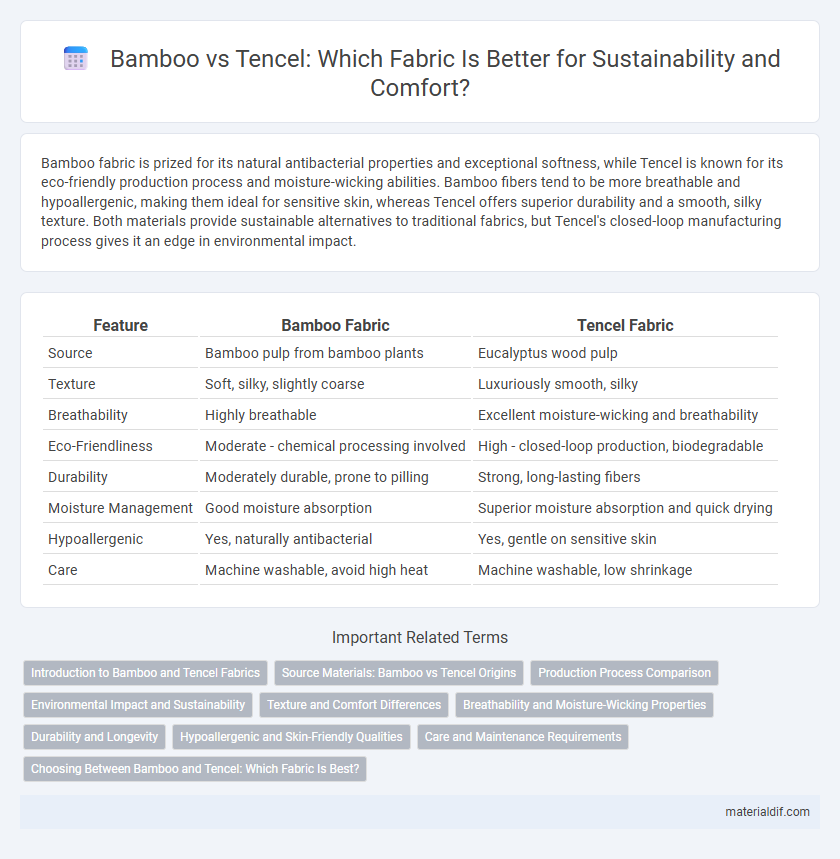Bamboo fabric is prized for its natural antibacterial properties and exceptional softness, while Tencel is known for its eco-friendly production process and moisture-wicking abilities. Bamboo fibers tend to be more breathable and hypoallergenic, making them ideal for sensitive skin, whereas Tencel offers superior durability and a smooth, silky texture. Both materials provide sustainable alternatives to traditional fabrics, but Tencel's closed-loop manufacturing process gives it an edge in environmental impact.
Table of Comparison
| Feature | Bamboo Fabric | Tencel Fabric |
|---|---|---|
| Source | Bamboo pulp from bamboo plants | Eucalyptus wood pulp |
| Texture | Soft, silky, slightly coarse | Luxuriously smooth, silky |
| Breathability | Highly breathable | Excellent moisture-wicking and breathability |
| Eco-Friendliness | Moderate - chemical processing involved | High - closed-loop production, biodegradable |
| Durability | Moderately durable, prone to pilling | Strong, long-lasting fibers |
| Moisture Management | Good moisture absorption | Superior moisture absorption and quick drying |
| Hypoallergenic | Yes, naturally antibacterial | Yes, gentle on sensitive skin |
| Care | Machine washable, avoid high heat | Machine washable, low shrinkage |
Introduction to Bamboo and Tencel Fabrics
Bamboo fabric is derived from the pulp of bamboo grass and is known for its natural antibacterial properties, breathability, and moisture-wicking abilities. Tencel, a branded lyocell fiber produced from sustainably sourced eucalyptus wood, offers exceptional softness, strength, and biodegradability. Both fabrics are eco-friendly alternatives to conventional textiles, favored for their comfort and reduced environmental impact in sustainable fashion.
Source Materials: Bamboo vs Tencel Origins
Bamboo fabric is derived from the cellulose of bamboo plants, which grow rapidly and require minimal pesticides, making it a sustainable raw material. Tencel, a branded form of lyocell, originates from sustainably harvested eucalyptus trees processed using a closed-loop system that recycles water and solvents, reducing environmental impact. Both sources emphasize eco-friendly cultivation but differ significantly in raw material type and manufacturing practices.
Production Process Comparison
Bamboo fabric production involves chemical processing methods such as the viscose or lyocell process to extract fibers, often requiring harsh chemicals like sodium hydroxide and carbon disulfide, which can impact environmental safety. Tencel, derived from sustainably sourced eucalyptus wood, utilizes a closed-loop lyocell process that recycles water and solvents with minimal emissions, making it more eco-friendly. The energy-efficient production and lower chemical use associated with Tencel contribute to its reputation as a sustainable textile alternative compared to traditional bamboo fabric manufacturing.
Environmental Impact and Sustainability
Bamboo fabric is highly sustainable due to its rapid growth and minimal need for pesticides, but traditional processing often involves chemical-heavy methods that impact the environment negatively. Tencel, produced from sustainably harvested eucalyptus trees through a closed-loop process, significantly reduces water usage and chemical waste, making it an environmentally superior choice. Both fabrics offer renewable sources, but Tencel's eco-friendly manufacturing process positions it as the leader in sustainability within the textile industry.
Texture and Comfort Differences
Bamboo fabric offers a silky texture with excellent moisture-wicking properties, making it soft and breathable for sensitive skin. Tencel, derived from eucalyptus, provides a smooth, cool finish with superior drape and wrinkle resistance, enhancing comfort in warm climates. Both fibers excel in softness, but Bamboo tends to feel more plush, while Tencel delivers a lightweight and crisp sensation.
Breathability and Moisture-Wicking Properties
Bamboo fabric excels in breathability due to its natural porous structure, allowing superior air circulation and cooling effects. Tencel, derived from eucalyptus trees, offers exceptional moisture-wicking properties by efficiently absorbing and releasing moisture, keeping the skin dry and comfortable. Both fabrics provide sustainable and hypoallergenic benefits, but Tencel typically outperforms bamboo in rapid moisture management for active wear.
Durability and Longevity
Bamboo fabric boasts natural antimicrobial properties and moderate durability, making it suitable for everyday wear but prone to faster wear with frequent washing. Tencel, derived from eucalyptus fibers, offers superior strength and resilience due to its lyocell production process, resulting in longer-lasting fabric that maintains softness and shape over time. Choosing Tencel enhances garment longevity while retaining eco-friendly benefits, outperforming bamboo in durability and sustained quality.
Hypoallergenic and Skin-Friendly Qualities
Bamboo fabric is highly hypoallergenic due to its natural antimicrobial properties, making it ideal for sensitive skin and allergy sufferers. Tencel, derived from eucalyptus wood pulp, offers excellent breathability and moisture-wicking capabilities that minimize skin irritation and promote comfort. Both fabrics provide sustainable, soft textures with superior skin-friendly qualities, but bamboo's inherent antibacterial traits give it a slight edge in hypoallergenic performance.
Care and Maintenance Requirements
Bamboo fabric requires gentle washing with cold water and mild detergent to maintain its softness and prevent shrinking, while it should be air-dried or tumble-dried on low heat to avoid damage. Tencel, made from sustainably sourced wood pulp, is durable and resists wrinkles, allowing for machine washing in cold or warm water with a gentle cycle, and is best air-dried or tumble-dried on low to preserve its smooth texture. Both fabrics benefit from avoiding harsh bleach and fabric softeners to extend their lifespan and maintain eco-friendly properties.
Choosing Between Bamboo and Tencel: Which Fabric Is Best?
Bamboo fabric offers excellent breathability and natural antibacterial properties, making it ideal for sensitive skin and hot climates, while Tencel, derived from sustainably sourced eucalyptus, excels with superior moisture-wicking and a silky-smooth texture. Tencel's eco-friendly production uses less water and energy, appealing to environmentally conscious consumers, whereas bamboo's rapid growth and biodegradability support sustainable fashion practices. Prioritizing softness, durability, and environmental impact will help determine whether bamboo or Tencel fabric best suits your textile needs.
Bamboo vs Tencel Infographic

 materialdif.com
materialdif.com